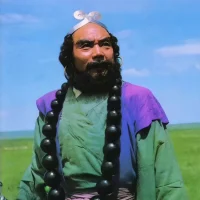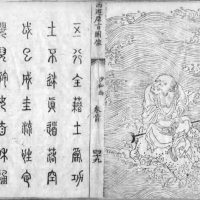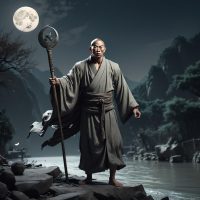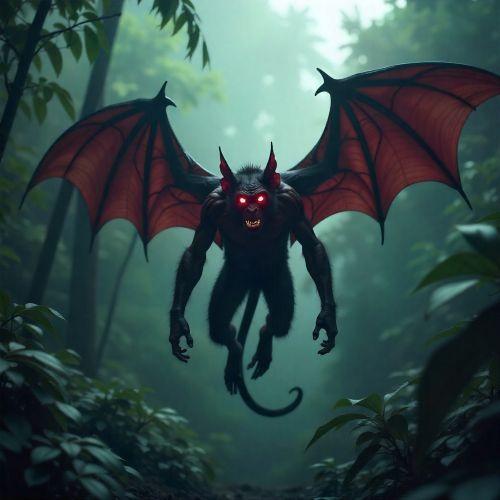Sha Wujing : The Sand Monk of Journey to the West
Listen
At a glance
| Description | |
|---|---|
| Origin | Chinese Mythology |
| Classification | Spirits |
| Family Members | N/A |
| Region | China |
| Associated With | Protection, Loyalty |
Shu Wujing
Introduction
Sha Wujing, known in Chinese as 沙悟净 and often translated as “Sand Awakened to Purity,” is one of the central figures in Journey to the West, the 16th-century Chinese literary masterpiece by Wu Cheng’en. A fallen celestial general turned penitent monk, Sha Wujing embodies themes of redemption, endurance, and loyalty. Though often overshadowed by the flamboyant Monkey King, Sun Wukong, and the gluttonous Zhu Bajie, Sha Wujing’s steadfast nature and quiet wisdom make him indispensable to the sacred pilgrimage of Tang Sanzang. His transformation from a man-eating river demon to a devoted Buddhist disciple mirrors the spiritual evolution central to the novel’s message of enlightenment through suffering and humility.
Before his fall, Sha Wujing served in Heaven as the “Curtain-Lifting General,” a position of great honor. His misfortune began when he accidentally shattered a valuable crystal goblet belonging to the Queen Mother of the West during a celestial banquet. For this offense, he was severely punished by the Jade Emperor—struck eight hundred times and banished to Earth, where he was reborn as a sand demon haunting the Flowing Sands River (Liusha River). He terrorized travelers until Guanyin, the Bodhisattva of Compassion, converted him and offered him a chance at salvation. Taking the name Sha Wujing, he pledged his service to Tang Sanzang, joining the pilgrimage to retrieve Buddhist scriptures from India.
Physical Traits
In Journey to the West, Sha Wujing is described as a tall, muscular being with an intimidating yet dignified presence. His complexion is often depicted as dark blue or indigo, his hair a fiery red or golden hue, symbolizing his transformation from a violent creature to a figure of spiritual awakening. Around his neck hang nine skulls—remnants of monks he had devoured before his conversion—serving as both a symbol of past sin and a reminder of his vow never to harm again.
He typically wears monk’s robes made from coarse fabric and carries his signature weapon, the crescent-moon spade (月牙铲, yuèyáchǎn). This unique staff, forged from celestial materials, functions both as a weapon and a ritual instrument for burial rites—emphasizing his dual role as warrior and monk. His fierce exterior conceals a deeply compassionate heart, a visual reflection of Buddhist teaching: that enlightenment can emerge even from darkness and imperfection.
As the pilgrimage progresses, Sha Wujing’s physical transformation mirrors his inner peace. Once seen as monstrous, his features gradually soften, symbolizing purification through devotion. Artists and storytellers often depict him standing at the riverbank, his weapon gleaming in the moonlight, a silent guardian embodying the triumph of repentance over sin.
Family
Unlike many mythological heroes, Sha Wujing’s story is devoid of blood relatives. His origins lie in the celestial realm rather than a mortal lineage, emphasizing his divine nature and detachment from worldly ties. After his exile, he lived alone for centuries in the Liusha River, isolated from both gods and men. This solitude shaped his calm temperament and deep humility.
During the pilgrimage, Tang Sanzang and his disciples become his spiritual family. Sun Wukong’s impulsiveness, Zhu Bajie’s indulgence, and Sha Wujing’s patience form a delicate balance—each representing a different aspect of the human condition. Wujing, often called the “peacekeeper,” mediates between the fiery Monkey King and the lazy Pigsy, ensuring harmony within the group. His familial role is not one of hierarchy but of quiet guidance, reflecting Buddhist ideals of compassion and cooperation.
Other names
Sha Wujing is known by several names across languages and adaptations, each reflecting a different aspect of his character. His full Buddhist name, “Sha Wujing,” literally means “Sand Awakened to Purity,” symbolizing his redemption from his demonic nature. In Chinese he is often called Sha Heshang (沙和尚) or Sha Seng (沙僧), both meaning “Monk Sha.” In English translations, he appears as “Friar Sand” or simply “Sandy.”
Before his banishment, he was the “Curtain-Lifting General” (卷帘大将), a celestial officer in the Jade Emperor’s court. His demotion and transformation into a river demon mark his descent from divine to mortal realms—a fall followed by eventual enlightenment. In other Asian cultures, he appears as Sa Gojō in Japan, Sa Ojeong in Korea, and Sa Tăng in Vietnam. Each version retains his symbolic connection to sand and purification, reinforcing his universal image as a penitent guardian who achieves holiness through humility.
Powers and Abilities
Sha Wujing possesses immense strength and mastery over both land and water. His crescent-moon spade is an extension of his spiritual energy, capable of expanding or contracting in size and delivering devastating blows to demons and spirits. Unlike Sun Wukong’s flamboyant magic or Zhu Bajie’s brute force, Wujing’s combat style emphasizes balance, endurance, and precision.
He is a master of the eighteen Di Sha transformations, enabling him to alter his appearance or adapt to different battle conditions. His aquatic abilities surpass those of his companions—he can control currents, breathe underwater, and transform into sand or mist, allowing him to traverse rivers and deserts effortlessly. As a former celestial general, he retains semi-divine resilience, making him nearly impervious to age or mortal wounds.
Beyond physical might, Sha Wujing’s greatest strength lies in his discipline. He rarely acts out of anger or pride, embodying the Buddhist path of the Middle Way. His composure provides stability during the pilgrims’ countless trials, while his humility earns him the respect of gods and mortals alike. By the end of the journey, he attains the title of “Golden Arhat” (金身罗汉), symbolizing complete spiritual liberation.
Modern Day Influence
Sha Wujing’s quiet nobility has inspired countless adaptations across film, television, literature, and gaming. Though often overshadowed by the flamboyant Sun Wukong, storytellers have reimagined him as a symbol of inner strength, humility, and redemption. In the iconic 1986 Journey to the West television series, Yan Huaili’s portrayal became the definitive image for generations, later succeeded by Liu Dagang in the second season. Internationally, he appears as Sha Gojō in Japanese adaptations like Saiyuki and Monkey Magic, often depicted as a stoic yet emotionally layered warrior. Modern Chinese films such as The Monkey King (2014–2023) continue to showcase him as a loyal and steadfast companion to Tang Sanzang, embodying unwavering faith and duty.
In contemporary art, comics, and literature, Sha Wujing often takes on a more introspective and philosophical tone. Graphic novels and manga reinterpret him as an antihero haunted by guilt and searching for spiritual redemption, turning his inner conflict into a mirror of human frailty and perseverance. In Buddhist art and temple iconography, his statues are frequently placed near rivers or bridges, symbolizing protection, purification, and safe passage. His narrative resonates deeply as a metaphor for confronting personal demons and transforming suffering into spiritual strength, a theme that continues to inspire modern audiences and artists alike.
His influence also extends into gaming and wider pop culture, where Sha Wujing-inspired characters appear in titles like Saiyuki: Journey West and Black Myth: Wukong. Game developers reinterpret his affinity with water and earth into mechanics that emphasize defense, balance, and resilience, reinforcing his role as a dependable guardian archetype. Across these interpretations, Sha Wujing remains a figure of quiet power—a reminder that true strength lies not in flamboyant displays or conquest, but in steadfast integrity, service, and the redemptive journey toward inner peace.
Related Images
Source
Wu, C. (1592/2023). Journey to the West. Translated by A. C. Yu. University of Chicago Press.
Journey to the West Research. (2018). The Origins and Evolution of Sha Wujing. Retrieved from https://journeytothewestresearch.com/
Wikipedia. (2025). Sha Wujing. Retrieved from https://en.wikipedia.org/wiki/Sha_Wujing
Monstropedia. (2024). Sha Wujing. Retrieved from https://www.monstropedia.org/
VBTutor. (n.d.). Journey to the West – Character Profiles (Sha Wu Jing). Retrieved from https://www.vbtutor.net/
Sciedu Press. (2024). Comparative Studies on English Translation of the Four Great Classical Novels. World Journal of English Language, 14(5), 39–40.
Reddit r/respectthreads. (2022). Respect Sha Wujing (Xi Xing Ji). Retrieved from https://www.reddit.com/
Journey to the West Xiyouji Fandom. (2024). Sha Wujing. Retrieved from https://journey-to-the-west-xiyouji.fandom.com/
Frequently Asked Questions
Who is Sha Wujing in Journey to the West?
Sha Wujing is one of the main disciples who accompanies Tang Sanzang on his pilgrimage, serving as a loyal protector and warrior.
What was Sha Wujing before joining the pilgrimage?
He was once a river-dwelling demon who was banished to Earth for breaking a heavenly treasure, eventually finding redemption by helping the monk.
What does Sha Wujing represent?
He symbolizes loyalty, humility, and perseverance, balancing the impulsiveness of Zhu Bajie and the boldness of Sun Wukong.
What weapons or skills does Sha Wujing have?
He wields a demon-subduing staff and possesses great physical strength, especially in battles against aquatic or monstrous enemies.
Why is Sha Wujing sometimes called the “Sand Monk”?
Because he once guarded the Flowing Sand River, a hostile desert river crossing, before joining the pilgrimage as a disciplined and peaceful monk.









